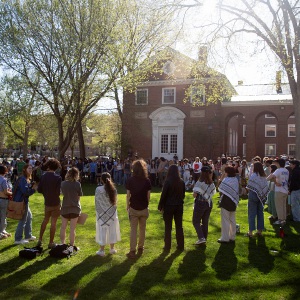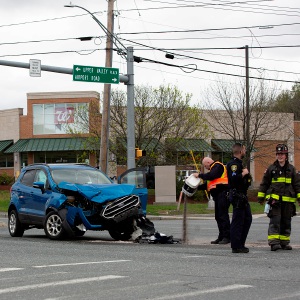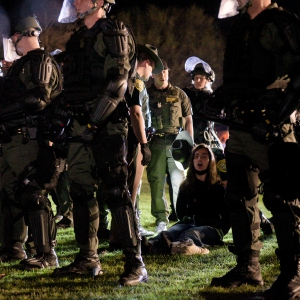Column: The vicious hit that changed football
| Published: 10-02-2021 10:10 PM |
Oct. 20 marks the 70th anniversary of one of the ugliest chapters in the desegregation of college football.
In many ways football was ahead of other team sports in North America in racial integration. At the professional level, Charles W. Follis became the first African American player when he played for the Shelby (Ohio) Athletic Club on Sept. 15, 1904. When representatives of 11 teams met to form the American Professional Football Association in 1920, they chose a Native American, the incomparable Jim Thorpe, as league president. Two years later, the association changed its name to National Football League.
All told, 13 African Americans played in the National Football League between 1920 and 1933. At the end of the 1933 season, however, NFL owners, including Tex Schramm, George Halas, Art Rooney and Tim Mara, established a color line. Most evidence suggests that George Preston Marshall, owner of the Boston (later Washington) Redskins, insisted on the policy, but Fritz Pollard, the league’s first African American player, claimed that Halas “was the greatest foe of black football players.” The exclusion of Black players from the NFL persisted until after World War II, when Kenny Washington joined the Los Angeles Rams.
Racial desegregation in college football proceeded — or not — along regional lines, with colleges in the North allowing, even recruiting, African American players while Southern schools resisted. Beginning at the turn of the 20th century, a so-called “gentlemen’s agreement” obtained by which Northern teams would not allow their Black players to compete when playing schools from the South. Sometimes, teams resorted to euphemism to justify the exclusion of Black athletes; in the 1929 contest against the University of Georgia, for instance, New York University physicians concocted a diagnosis of “damaged acromiclavicular ligament” to justify the benching of their African American star, Dave Myers.
When Johnny Bright and the Drake University Bulldogs traveled to Stillwater, Okla., for a game against Oklahoma A&M College (now Oklahoma State University) in 1949, there was no incident, even though Bright, the Bulldogs quarterback, was African American. By the time Drake returned to Stillwater two years later, however, Bright had established himself as a star. He broke the NCAA’s career rushing record the previous year and was considered a favorite for the Heisman Trophy, college football’s highest honor.
All week during practice, the Oklahoma A&M coach, J. B. Whitworth, had enjoined his players to “get that n-----”; both the local newspaper and the student newspaper reported in the days leading up to the game that Bright was a marked man. It was an open secret on the Stillwater campus that Bright would not be around by the end of the game.
Three times during the game’s opening seven minutes, Wilbanks Smith, an Oklahoma A&M lineman and team captain, crashed his forearm into Bright’s face — after the quarterback had handed off the ball and was observing the play. The third hit shattered Bright’s jaw. The Drake quarterback nevertheless stayed in the game and completed a 61-yard touchdown pass.
Another violent hit finally forced Bright from the game, which Oklahoma A&M won, 27-14. It was the first time in Bright’s three-year career that he finished a game with fewer than 100 yards. Adding insult to injury, a ticket agent at the Stillwater station refused to allow the injured Bright to sit with his white teammates on the ride home to Des Moines.
Article continues after...
Yesterday's Most Read Articles
 Dartmouth administration faces fierce criticism over protest arrests
Dartmouth administration faces fierce criticism over protest arrests
 West Lebanon crash
West Lebanon crash
 Plan on track to ship Upper Valley mail to Connecticut for sorting
Plan on track to ship Upper Valley mail to Connecticut for sorting
 Lebanon’s Jewell back from auto accident, more aware of ‘drowsy driving’ dangers
Lebanon’s Jewell back from auto accident, more aware of ‘drowsy driving’ dangers
 Longtime employees buy West Lebanon pizzeria
Longtime employees buy West Lebanon pizzeria
The line between honest competition and racial targeting is always difficult to define in any sport, but it’s especially challenging in a sport like football, where violence is embedded in the game itself. In 1923, for instance, Jack Trice, the first African American athlete at Iowa State University, suffered fatal injuries during his first football game, against the University of Minnesota.
In the Johnny Bright incident, however, the intent was less ambiguous. The Tulsa Daily World reported that Smith “hit Bright with such force that both his feet were off the ground.” A sequence of photographs published the following day in the Des Moines Register established both the intent and the effects of the blow.
“You never hit a person that many times unless you do it on purpose,” Bright said. The photographs, reproduced in The New York Times and Life magazine, later won a Pulitzer Prize.
Because of his limited playing time, Bright finished fifth in the Heisman Trophy balloting; he nevertheless scored 70% of Drake’s points that season. He was drafted in the first round by the Philadelphia Eagles but, wary of ongoing racism, chose to play in the Canadian Football League, retiring in 1964 as the CFL’s all-time leading rusher. Bright was inducted into the CFL Hall of Fame in 1970.
Both Wilbanks Smith and Oklahoma A&M refused to take responsibility for the Stillwater incident. Whitworth, the coach, denied that his players had “ganged up” on Bright, though he later apologized. Drake withdrew from the Missouri Valley Conference after officials refused to investigate what Drake called a “vicious and premeditated” attack.
The violence of the Johnny Bright incident called attention to the persistent racism in college football and helped prompt the NCAA to require face guards on helmets. Oklahoma State University formally apologized for the incident in 2005.
Johnny Bright died of a heart attack in 1983. Wilbanks Smith died in 2020. He never apologized.
Randall Balmer teaches at Dartmouth College. His book on team sports in North America, To Everything a Season, will be published next year by the University of North Carolina Press.

 Editorial: Response to campus protests only adds fuel to the fire
Editorial: Response to campus protests only adds fuel to the fire Editorial: Chris Sununu’s moral vacuum
Editorial: Chris Sununu’s moral vacuum Editorial: Gambling tarnishes America’s sporting life
Editorial: Gambling tarnishes America’s sporting life By the Way: A white nationalist’s many mistruths
By the Way: A white nationalist’s many mistruths
